The Huawei Mate 30 Pro Review: Top Hardware without Google?
by Andrei Frumusanu on November 27, 2019 10:00 AM EST- Posted in
- Mobile
- Smartphones
- Huawei
- Kirin 990
- Mate 30 Pro
Display Measurement
The display of the Mate 30 Pro is its most important feature (isn’t it for most phones?), and Huawei did some odd choices in terms of both design as well as hardware this year. I’ve covered the design choices in the introduction and fair to say I’m not too big a fan of the side curved display as it doesn’t work well ergonomically nor does it look well with Huawei’s choice of display panel. Although we weren’t able to confirm if the display is an LG or BOE panel, it’s definitely not a Samsung panel as it has issues in regards to colour shift on off-axis viewing angles.
Huawei this year also opted to downgrade the screen resolution from 1440p of the Mate 20 Pro to 1080p (well, 1176p), which does come with a notable reduction in screen sharpness, which is a pity given the device's price tag.
In terms of colour calibration and modes, we have the usual selection of a choice between a “Normal” sRGB target and a “Vivid” P3 gamut target, with three colour temperature presets which are fully customisable through a colour palette selector. Unfortunately, I didn’t see colour management working at all on the Mate 30 Pro, so Huawei is definitely behind other vendors this year (Android as a whole is quite far behind Apple to be honest).
We move on to the display calibration and fundamental display measurements of the Mate 30 Pro screen. As always, we thank X-Rite and SpecraCal, as our measurements are performed with an X-Rite i1Pro 2 spectrophotometer, with the exception of black levels which are measured with an i1Display Pro colorimeter. Data is collected and examined using Portrait Display's CalMAN software.

In terms of maximum brightness, the Mate 30 Pro is quite conservative and we don’t see brightness levels exceeding 437 nits. Unlike the Samsung panels in the P30 series, the Mate 30 Pro doesn’t look like it has any brightness boost mode when under adaptive brightness as the maximum doesn’t change no matter the ambient light.
Greyscale accuracy of the Mate 30 Pro isn’t too bad. Gamma is generally ok, with an ever so slight shift with too high gamma at the medium intensity levels, meaning shades are slightly darker. Colour temperature is a bit too warm on our unit, and this error actually increases the higher the brightness setting, with 6281K at 200nits and a low 6099K at maximum brightness. This results in the screen appearing to have a red tint.

The dE2000 results end up middle of the pack; the phone unfortunately ends up being quite worse than the Mate 20 Pro as well as slightly worse than the P30 Pro in terms of accuracy.

sRGB accuracy in the “Normal” mode isn’t very good. We’re seeing noticeable hue shits in the spectrum, especially in greens. The saturation and luminosity is also off-target as tones are too bright / undersaturated. The resulting dE2000 is quite bad, which sadly enough is in line with what we saw on the P30 Pro as well as the Mate 20’s.
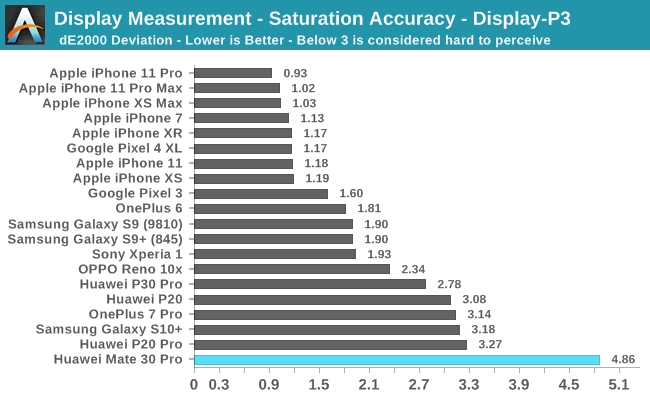
While the score of the Mate 30 Pro is really bad in the P3 measurements, most of the errors here is due to the wildly blue default colour temperature. Hues in this mode are actually more accurate than the sRGB mode, once of course you customize the colour temperature to more accurate levels.

In the GMB test in the Normal mode again the biggest errors are exhibited in the chromacity and hue of some tones, being a bit undersaturated as well as having hue issues in the green tones. The overall result is still acceptable and useable.
Screen Conclusion – Very Mediocre For a 1100€ Phone
The worse than usual viewing angles of the display, lower than expected resolution, low peak brightness, lower colour accuracy, no colour management all make this an extremely mediocre display for what is supposed to be a flagship device from Huawei. Unfortunately, we’ve seen the issue repeated again and again and frankly I don’t understand why vendors would opt to chose second-rate panels from LG or BOE in their flagship devices. If you’re going to build a 1100€ phone like the Mate 30 Pro, you should at least go all the way and source the highest quality panels you can get, as otherwise you’ll end up with a deal-breaker scenario for your product. The Mate 30 Pro’s screen is very underwhelming and given the phone’s price, is a deal breaker for me.



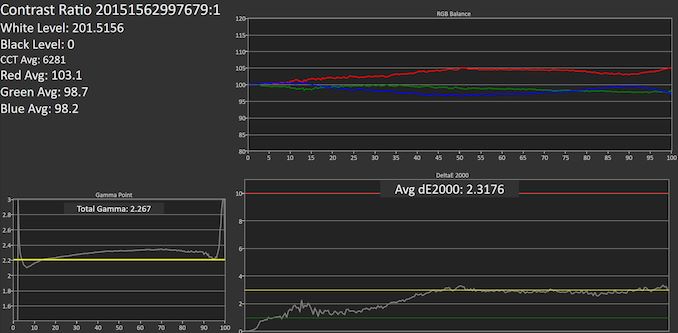

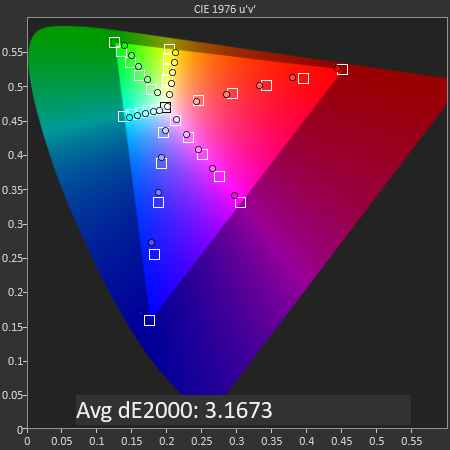
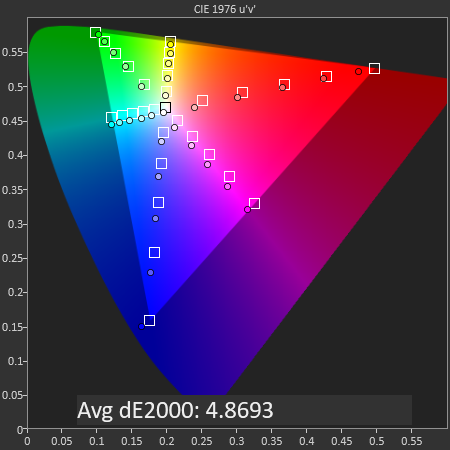
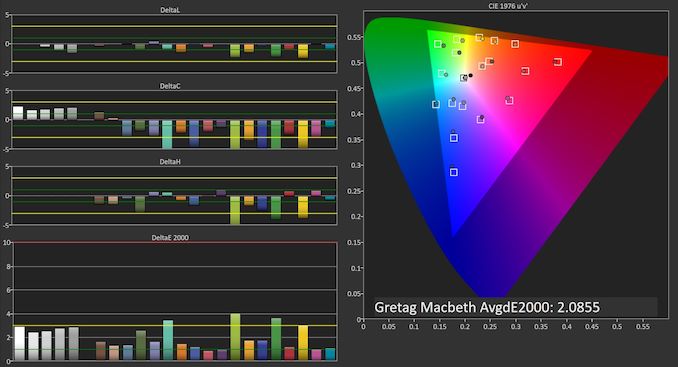









58 Comments
View All Comments
s.yu - Thursday, November 28, 2019 - link
"a unique 90° curved screen on its sides – a first not only for Huawei but for the smartphone market overall"...IIRC NEX 3 with the same screen curve design was launched 3 days before this model.
But the comments regarding the ergonomics certainly push me further towards the ROGP2.
"The new sensor is a native 16:9 unit" really surprises me as I thought it was a 3:2, since it shoots stills in 3:2, in this case the 4:3 crop in night mode would be even more of a compromise cutting out a larger portion of the sensor, essentially highlighting how severe the falloff and in cam shadow lifting is.
But this doesn't explain the poor DR of the new unit.
If I were shooting an UWA I'd probably prefer a narrower one, as the ~12mm FoV is overdramatic and incredibly difficult to master, but this isn't the main issue as I don't believe a significantly relevant proportion of users of these ultimately consumer devices actually understand photography enough to have that in mind.
The night mode on the UWA still has severe smearing that hasn't been resolved, especially obvious in the shot of the theater, whose exacerbation in edges and corners under a certain lighting threshold is observable in the 2nd sample on the stairs, so what I observed from GSMA's very few night samples turns out to be universal, that the UWA night mode on this big big sensor is actually worse than Samsung's tiny tiny sensor with a far wider FoV. Peculiar.
So the conclusion here is: When not much FoV is needed, DR isn't too extreme, and lighting is either sufficient enough not to need night mode or lacking enough that Samsung's tiny sensor tends to capture no data, this new UWA has the advantage.
A minor detail regarding "The ISO51200 of the sensor in the regular mode is able to get better results than the image stacking of ISO1600 pictures in night mode." The ISO1600 is probably calculated from the accumulated shutter durations of the burst, I don't believe it's likely that a burst could be captured without vibration under this lighting with each shot at ISO1600.
Finally, I was expecting a sprinkler test of the "7680fps", and preferably a test on effective video resolution, shame this wasn't included.
Andrei Frumusanu - Thursday, November 28, 2019 - link
You are right about the 3:2, I was absentmindedly writing 16:9.In regards to the slow-mi, Ian did an article few months back:
https://www.anandtech.com/show/14897/a-day-with-th...
The capture is just 2000fps interpolated 4x, I investigated this in the software.
s.yu - Thursday, November 28, 2019 - link
Yeah I know, just that a running tap was too slow, while a sprinkler test would yield more as to how the interpolation is done, e.g. the NPU technically should be able to afford some object tracking resulting in much better interpolation than mere averaging or something.Also a comparison of resolution between all the slow-mo that on paper appear to be 720P could help assess actual quality, my second point.
Dazzler86 - Thursday, November 28, 2019 - link
Eventhough the DR is not up to the unrealistic level of Samsung, its subtle enough & flagship grade.Whining about Night Mode? The Mates doesnt even need to use Night Mode to beat other competition, its still a low light king, as stated by the review.
Funny that you only stated negativity about the camera phone but ignores its pros that beat others. Best UWA implentation, best detail preservation on a smartphone camera, ever.
I dont care about your other post about their politics, but i know i made the right choice, choosing Huawei for a point & shoot camera along with my main Leica Q & Fuji X-E3.
s.yu - Thursday, November 28, 2019 - link
Oh I know a Huawei fanboy when I see one alright."Eventhough the DR is not up to the unrealistic level of Samsung, its subtle enough & flagship grade."
So more DR than Huawei equals unrealistic? lol. Apple's UWA output also has more DR and is quite realistic. The processing of the two Samsung variants is also different, and not entirely less realistic than for example P30P.
"The Mates doesnt even need to use Night Mode to beat other competition"
Rather that it would lose to others where it might have won without night mode?
The Mate, which on auto:
https://images.anandtech.com/galleries/7356/Mate30... beats Samsung's night mode(for as wide as its FoV would cover): https://images.anandtech.com/galleries/7356/S10E_2...
loses handily to Samsung's night mode with its own night mode: https://images.anandtech.com/galleries/7356/Mate30...
with much narrower FoV, much more severe smearing etc.
This inconsistency, a strong argument against night mode use in many nighttime conditions, is a liability, because the user is forced to guess when night mode works better and when it's far worse, and the penalty for making a mistake in judgement is a heavy one.
Andrei left out a lot of individual analysis between samples, but clearly there are too many catches for it to be declared outright "king", which I summarized as "When not much FoV is needed, DR isn't too extreme, and lighting is either sufficient enough not to need night mode or lacking enough that Samsung's tiny sensor tends to capture no data, this new UWA has the advantage."
Note that I acknowledge the advantage, where there is one, only I also acknowledge the disadvantage, where there is one, unlike you who does nothing but brag.
"Best UWA implentation"
is, again, false. You don't say that a 21/2 is better than a 12/5.6, because the drastic difference in FoV makes then incomparable, and the UWA, already ~18mm in stills, a 1.5x crop compared to Samsung and Apple's UWA, is a ~21mm equiv. FoV in night mode's forced 4:3 crop, so no matter how much cleaner it is, you can't call it something along the lines of "the best". Your claim is akin to "my 16-35/2.8 is better than your 12-24/4", or "my 50/0.95 is better than your 75/1.4", which is nothing but ignorant fanboy talk. You're lucky this is Anandtech, or else you'd be laughed at commenting like that under DPR.
Also some things I left unsaid as I already covered some of Mate30P's performance in the comments of the Pixel 4 review, I felt no need to repeat them.
"Leica Q"
You bought an expensive toy that will go to waste in your hands. Your X-E3 purchase does expose your taste for JPG filters over material performance gain though, not surprising for a Huawei fanboy.
SydneyBlue120d - Thursday, November 28, 2019 - link
Thank You Andrei for your great review!After all this years of Android it is really disappointing that still at the end of 2019 no one seems to be able to beat the iPhone 11 PRO display accuracy.
phils1969 - Thursday, November 28, 2019 - link
Anyone else had an issue with the Nano Memory card not being detected? Dual sim works so the slots fine, but 1 sim and 1 NM card and its not seeing the NM card, the wifes Mate 20 Pro sees it fine so its not the card?Calista - Thursday, November 28, 2019 - link
If anything this shows we really need properly split Alphabet/Google from Android. Android being open source, it belongs to the world. But that's not much use if it's still locked to a single company in a country more than happy to be both judge, jury and executioner when it comes to world politics. All the major cellphone vendors should work together to replace the Google services with open alternatives. It's easy to pick on Huawei, but what's the next target? Samsung? Oppo? LG? Sony? Some other company not from USA?liquid_c - Saturday, November 30, 2019 - link
In the pfw chart, the iPhones get 2 subsections (cold/peak and hot) while the other devices, don’t. Why is that?AidenP - Saturday, December 7, 2019 - link
Looks decent (except for those extra curved sides) ,and the specs are up there,it seems, I think at 500-600 Euros would be a realistic value offer , but for now I will stick to my iPhone 8,for at least a few more years .